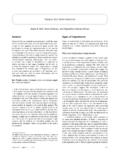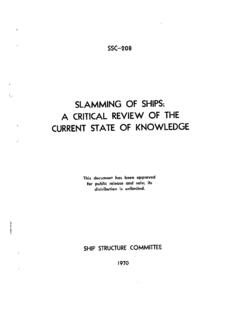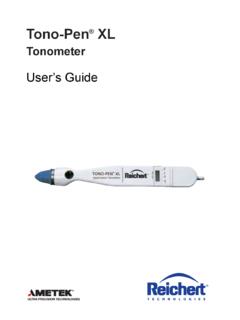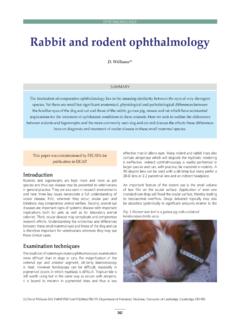Transcription of Guidelines for the Design and Statistical Analysis of ...
1 Guidelines for the Design and Statistical Analysis of ExperimentsUsing Laboratory AnimalsMichael F. W. Festing and Douglas G. AltmanAbstractFor ethical and economic reasons, it is important to designanimal experiments well, to analyze the data correctly, andto use the minimum number of animals necessary to achievethe scientific objectives but not so few as to miss biologi-cally important effects or require unnecessary repetition ofexperiments. Investigators are urged to consult a statisticianat the Design stage and are reminded that no experimentshould ever be started without a clear idea of how the re-sulting data are to be analyzed. These Guidelines are pro-vided to help biomedical research workers perform theirexperiments efficiently and analyze their results so that theycan extract all useful information from the resulting the topics discussed are the varying purposes ofexperiments ( , exploratory vs.)
2 Confirmatory); the experi-mental unit; the necessity of recording full experimentaldetails ( , species, sex, age, microbiological status, strainand source of animals, and husbandry conditions); assigningexperimental units to treatments using randomization; otheraspects of the experiment ( , timing of measurements);using formal experimental designs ( , completely ran-domized and randomized block); estimating the size of theexperiment using power and sample size calculations;screening raw data for obvious errors; using thet-test oranalysis of variance for parametric Analysis ; and effectivedesign of graphical Words:animal experiments; experimental Design ; sta-tistics; variationIntroductionExperiments using laboratory animals should be welldesigned, efficiently executed, correctly analyzed,clearly presented, and correctly interpreted if they areto be ethically acceptable.
3 Unfortunately, surveys of pub-lished papers reveal that many fall short of this ideal, and insome cases, the conclusions are not even supported by thedata (Festing 1994; Festing and Lovell 1995, 1996; Mc-Cance 1995). This situation is unethical and results in awaste of scientific resources. In contrast, high-quality meth-ods will help to ensure that the results are scientificallyreliable and will not mislead other aim of these Guidelines is to help investigators whouse animals ensure that their research is performed effi-ciently and humanely, with the minimum number ofanimals to achieve the scientific objectives of the knowledge of statistics is assumed because most sci-entists will have had some training in this discipline. How-ever, scientists using animals should always have access toa statistician who can help with unfamiliar or Guidelines and suggestions for further reading arebased partly on previously published Guidelines for con-tributors to medical journals (Altman et al.)
4 2000) and for invitro experiments (Festing 2001). Although a useful set ofguidelines for appropriate Statistical practice in toxicol-ogy experiments has previously been published (Muller etal., 1984), with a more extensive set of suggestions for thedesign and Analysis of carcinogenicity studies (Fairweatheret al. 1998), general Guidelines aimed specifically at experi-ments using laboratory animals in both academic and ap-plied research do not appear to have been publishedrecently. However, a recent book covers in more detailmuch of the ground discussed here (Festing et al. 2002).Although responsibility for the quality of research restsclearly with those who perform it, we believe journal editorsshould ensure adequate peer review by individuals knowl-edgeable in experimental Design and statistics. They shouldalso ensure that there is a sufficiently full description ofanimals, experimental designs, and Statistical methodsused and should encourage the discussion of published pa-pers through letters to the editor and, when possible, bysuggesting that authors publish their raw data electronically(Altman 2002).
5 Ethical ConsiderationsThe use of animals in scientific experiments likely to causepain, distress, or lasting harm generates important ethicalissues. Animals should be used only if the scientific objec-tives are valid, there is no other alternative, and the cost tothe animals is not excessive. Validity in this case impliesthat the experiment has a high probability of meeting thestated objectives, and these objectives have a reasonableMichael F. W. Festing, , , , CStat., BIBiol., is a SeniorResearch Scientist at the MRC Toxicology Unit, University of Leicester,UK. Douglas G. Altman, , , is Director of the Cancer ResearchUK/NHS Centre for Statistics in Medicine, Institute of Health Sciences,Headington, Oxford, of contributing to human or animal welfare, possiblyin the long following 3Rs of Russell and Burch (1959)provide a framework for considering the humane use ofanimals: Animals should bereplacedby less sentient alternativessuch as invertebrates or in vitro methods wheneverpossible.
6 Experimental protocols should berefinedto minimizeany adverse effects for each individual animal. For ex-ample, appropriate anesthesia and analgesia should beused for any surgical intervention. Death is not an ac-ceptable endpoint if it is preceded by some hours ofacute distress, and humane endpoints should be usedwhenever possible (Stokes 2000). Staff should be welltrained, and housing should be of a high standard withappropriate environmental enrichment. Animals shouldbe protected from pathogens. The number of animals should bereducedto the mini-mum consistent with achieving the scientific objectivesof the study, recognizing that important biological ef-fects may be missed if too few animals are used. Somethought also should be given to the required precision ofany outcomes to be measured. For example, chemicalsare classified into a number of groups on the basis oftheir acute toxicity in animals.
7 It may not be necessaryto obtain a highly precise estimate of the median lethaldose (LD50value) to classify them. A number of se-quential experimental designs that use fewer animalshave been developed for this purpose (Lipnick et ; Rispin et al. 2002; Schlede et al. 1992). Ethicalreview panels should also insist that any scientist whodoes not have a good background in experimental de-sign and statistics should consult a PrinciplesAll research should be described in such a way that it couldbe repeated elsewhere. Authors should clearly state thefollowing: The objectives of the research and/or the hypotheses tobe tested; The reason for choosing their particular animal model; The species, strain, source, and type of animal used; The details of each separate experiment being reported,including the study Design and the number of animalsused; and The Statistical methods used for and SurveysAnexperimentis a procedure for collecting scientific dataon the response to an intervention in a systematic way tomaximize the chance of answering a question correctly(confirmatory research) or to provide material for thegeneration of new hypotheses (exploratory research).
8 Itinvolves some treatment or other manipulation that isunder the control of the experimenter, and the aim is todiscover whether the treatment iscausinga response in theexperimental subjects and/or to quantify such response. Asurvey, in contrast, is an observational study used to findassociationsbetween variables that the scientist cannot usu-ally control. Any association may or may not be due to acausal relation. These Guidelines are concerned only should be planned before they are started,and this planning should include the Statistical methods usedto assess the results. Sometimes a single experiment isreplicated in different laboratories or at different , if this replication is planned in advance and thedata are analyzed accordingly, it still represents a and Exploratory ExperimentsConfirmatory research normally involves formal testing ofone or more prespecified hypotheses.
9 By contrast, explor-atory research normally involves looking for patterns in thedata with less emphasis on formal testing of , exploratory experiments involve many charac-ters. For example, many microarray experiments in whichup or down regulation of many thousands of genes is as-sayed in each animal could be classified as exploratory ex-periments because the main purpose is usually to look forpatterns of response rather than to test some prespecifiedhypotheses. There is frequently some overlap between thesetwo types of experiment . For example, an experiment maybe set up to test whether a compound produces a specificeffect on the body weight of rats a confirmatory , data may also be collected on hematology andclinical biochemistry, and exploratory investigations usingthese data may suggest additional hypotheses to be tested infuture confirmatory Involving Several ExperimentsScientific articles often report the results of several inde-pendent experiments.
10 When two or more experiments arepresented, they should be clearly distinguished and eachshould be described fully. It is helpful to readers to numberthe as Models of Humans orOther SpeciesLaboratory animals are nearly always used as models orsurrogates of humans or other species. A model is a repre-Volume 43, Number 42002245sentation of the thing being modeled (the target). It musthave certain characteristics that resemble the target, but itcan be very different in other ways, some of which are oflittle importance whereas others may be of great practicalimportance. For example, the rabbit was used for manyyears as a model of diabetic humans for assaying the po-tency of insulin preparations because it was well establishedthat insulin reduces blood glucose levels in rabbits as wellas in humans. The fact that rabbits differ from humans inmany thousands of ways was irrelevant for this particularapplication.






